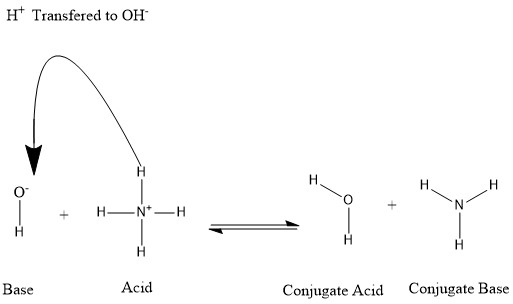Conjugate base
A conjugate acid, within the Brønsted–Lowry acid–base theory, is a species formed by the reception of a proton (H+) by a base—in other words, it is a base with a hydrogen ion added to it. On the other hand, a conjugate base is merely what is left after an acid has donated a proton in a chemical reaction. Hence, a conjugate base is a species formed by the removal of a proton from an acid.
In summary, this can be represented as the following chemical reaction:
Johannes Nicolaus Brønsted and Martin Lowry introduced the Brønsted–Lowry theory, which proposed that any compound that can transfer a proton to any other compound is an acid, and the compound that accepts the proton is a base. A proton is a nuclear particle with a unit positive electrical charge; it is represented by the symbol H+ because it constitutes the nucleus of a hydrogen atom, that is, a hydrogen cation.
A cation can be a conjugate acid, and an anion can be a conjugate base, depending on which substance is involved and which acid–base theory is the viewpoint.
In an acid-base reaction, an acid plus a base reacts to form a conjugate base plus a conjugate acid:
Conjugates are formed when an acid loses a hydrogen proton or a base gains a hydrogen proton. Refer to the following figure:
We say that the water molecule is the conjugate acid of the hydroxide ion after the latter received the hydrogen proton donated by ammonium. On the other hand, ammonia is the conjugate base for the acid ammonium after ammonium has donated a hydrogen ion towards the production of the water molecule. We can also refer to OH- as a conjugate base of H
2O, since the water molecule donates a proton towards the production of NH+
4 in the reverse reaction, which is the predominating process in nature due to the strength of the base NH
3 over the hydroxide ion. Based on this information, it is clear that the terms "Acid", "Base", "conjugate acid", and "conjugate base" are not fixed for a certain chemical species; but are interchangeable according to the reaction taking place.
...
Wikipedia

